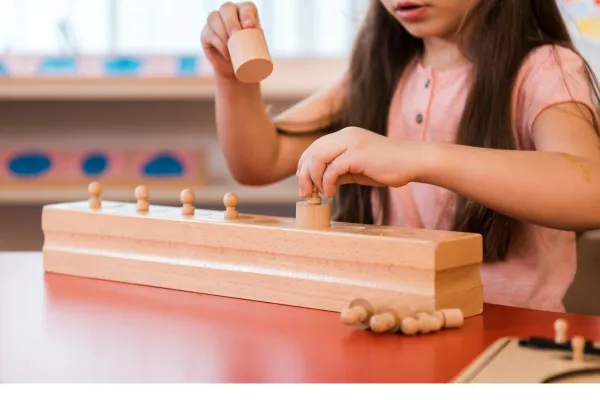
The Importance of Sensorial Work for Young Children
Cover Photo: Knobbed Cylinders in Action
In the Montessori environment, Sensorial work plays a crucial role in a child’s development, honing their senses and preparing them for more complex learning. The cover photo showcases a child deeply engaged with the knobbed cylinders, one of the foundational materials in Montessori Sensorial education. The child’s focus on this activity illustrates the importance of refining their sense of size, shape, and spatial awareness. This work not only aids in cognitive development but also in fine motor skills, as the child practices precise movements to fit the cylinders into their corresponding slots.
Introduction to Geometry and Order
The first set of images introduces us to two essential aspects of Sensorial work. On the left, a child is matching geometric solids, a fundamental activity that lays the groundwork for mathematical understanding. By exploring these 3D shapes, the child is learning to categorize and recognize different geometrical forms, which is a precursor to more advanced math concepts like geometry.

On the right, the pink and brown stairs are arranged horizontally on a dinner tray. This setup emphasizes the child's exploration of order and sequencing, key concepts in both math and language development. The deliberate placement of the brown stairs alongside the pink ones helps children visualize and internalize differences in dimensions, reinforcing their understanding of size and gradation.
Sound Cylinders - Tuning into the World
The next image captures a child matching sound cylinders, an activity that sharpens auditory discrimination. Each cylinder emits a different sound when shaken, encouraging the child to listen carefully and match the sounds. This activity is more than just fun; it develops concentration, memory, and the ability to differentiate between subtle variations in sound. This skill is particularly valuable as it supports language development, helping children discern different phonetic sounds, which is critical for reading and communication.

A Symphony of Color and Shape
The third set of images highlights the beauty and precision of Montessori Sensorial materials. On the left, the colored knob less cylinders are arranged in a star pattern on a mat. This not only appeals to a child’s sense of aesthetics but also reinforces their understanding of color gradation, size, and sequencing. The child is learning to organize and classify, skills that are foundational for future academic success.
On the right, we see a child working with the blue constructive triangles, a versatile material that introduces the concepts of geometry, fractions, and symmetry. By manipulating these triangles, children gain an intuitive understanding of how shapes can be combined and transformed, laying the groundwork for later math learning.

Why Sensorial Work Matters
Sensorial work is not just about the individual activities; it’s about developing a child’s ability to observe, compare, and classify their environment. These exercises sharpen the child’s senses and build a solid foundation for learning in all areas. When children engage with Sensorial materials like those shown in the photos, they are developing crucial skills that will support their cognitive, emotional, and physical growth.
Each piece of material in the Montessori Sensorial curriculum is designed with a specific purpose in mind, whether it’s refining a child’s sense of touch, sight, sound, or even taste and smell. By systematically working through these materials, children learn to make sense of the world around them, organizing their sensory experiences into a coherent framework.
Moreover, Sensorial work fosters independence and confidence. As children successfully navigate these activities, they gain a sense of accomplishment and pride in their abilities. This self-confidence carries over into other areas of their lives, encouraging them to take on new challenges with enthusiasm.
Final Thoughts
The photos beautifully capture the essence of Sensorial work in the Montessori classroom, demonstrating how these activities engage children’s senses, build essential skills, and prepare them for future academic and personal success. Whether it’s the precise placement of the knobbed cylinders, the exploration of geometric solids, or the intricate patterns created with knobbless cylinders, each activity serves a vital role in the child’s development. Through Sensorial work, children not only learn about the world around them but also about themselves, discovering their capabilities and the joy of learning.

